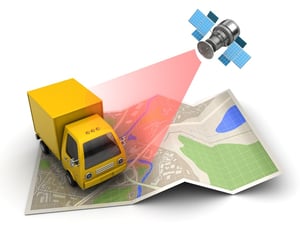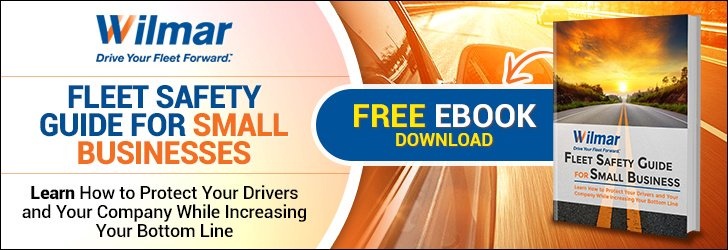
For small and mid-sized businesses with fleets, there are few topics more pertinent to the long-term financial health of your company than fleet safety. Even with the best possible preparation, accidents happen. A safer environment for employees and motorists on the road is beneficial for every company that operates a fleet of any size.
Let’s take a look at a few key stats that show just how important fleet safety is to companies of all sizes:
- Each year, an estimated 20% of all fleet vehicles are involved in an accident, according to the National Association of Fleet Administrators.
- Smart driving not only limits a company’s risk and exposure, smart driving practices like gentle acceleration and smooth breaking can improve fuel economy by as much as 33%, according to the US Environmental Protection Agency.
- 1 in 4 fatal work injuries involves a vehicle accident.
- The average crash costs an employer $16,500, with costs exceeding $500,000 when a fatality is involved according to OSHA.
Reaching your fleet safety goals can be difficult. Large companies may be able to spend their way out of the problem with intensive training and high-cost services, but around the world, most mid-sized fleets struggle to measurably reduce costs associated with accidents, driver behavior, and fleet safety.
Fortunately, there are options that can reliably improve fleet safety and the costs associated with fleet maintenance for companies without a lot of extra capital to invest. By outlining a few key processes, you can put yourself in a position to hire better drivers, train them to minimize damages, and take better care of your vehicles.
This, combined with help from fleet safety tech can have a big impact on small and mid-sized fleets and improve their bottom line.
Company Culture Plays a Big Role

Ultimately, employees care about driving safety when their employer makes fleet safety a true priority within the company. By establishing ongoing training programs and making driver safety a big focus in your daily work, your drivers will make it a priority as well. But making driver safety a priority will take a concerted effort.
Too many companies make fleet safety an afterthought, only dealing with safety issues when accidents happen, and issues arise. By then, drivers have already been put in dangerous situations and the company has already suffered financially for mistakes and accidents that may have been able to be avoided. By making safety a daily focus, your drivers will make it a priority as well.
According to OSHA, motor vehicle crashes cost employers $60 billion annually. That number includes healthcare, legal expenses, property damages, and productivity lost. While creating a culture of safety does require some up-front investment, that investment is certain to pay off in the long-term. Even a small number of fewer accidents per year can have a measurable effect on your bottom line.
Selecting the Right Vehicles

Choosing the right vehicles is critical for fleet safety. There are a lot of questions that need to be taken into account as you look to lease vehicles for your fleet. How many passengers and loads will the vehicles haul?
Will they be pulling a trailer? Will you be installing any racks or making any modifications to the vehicle to fit your specifications?
These are all important questions that will play a role in your safety processes, so it is important that you have them outlined before making any critical decisions.
Companies must find a happy balance between current needs and estimated future needs. You may believe that you will need to lease larger vehicles in the near future, but is it worth it considering that it will increase the difficulty of driving the vehicle until that time? Always take safety reports for vehicles into account before leasing or buying vehicles.
Driving Records & Licensing
Companies with fleets will have a number of local laws that they must adhere to before putting commercial vehicles on the road. But, companies should go above and beyond local laws and establish requirements that they think will result in positive outcomes. Driver records contain a lot of relevant information for evaluating a driver’s ability.
They include convictions for traffic violations, crimes, suspensions, cancellation of driving privileges, and revocations. Information about past accidents is especially pertinent before bringing a driver on board.
All companies with fleets should check driving records and contact references from previous employers about a prospective employee’s record as a driver. When evaluating drivers, don’t just look at the number of moving violations, take the severity of the violations into account as well.
Defensive Driving Training
Providing your drivers with defensive driving training is absolutely essential for improving the safety of your fleet. With so much capital and people’s lives at stake, it is important that your teams know how to put themselves in the best position for positive outcomes while on the road.

Defensive driving training can cover many different areas of the driving experience.
Most programs start by addressing the importance of having a positive driving attitude because most risky driving maneuvers happen while drivers feel stressed or respond poorly to an incident on the road.
Learning the basic defensive driving techniques can be a great way to mitigate accidents and put your drivers in a position for success. In-depth defensive driving courses don’t just go over what you’d learn in your driver’s handbook.
They dig deeper into steps that drivers can take to separate risks and minimize the chances of a crash while on the road. Defensive driving is critical for all drivers but is especially critical for drivers that will be operating larger vehicles in crowded roadways.
There are many options when it comes to defensive driving training. While some companies will come to your place of business and hold one-day or multiple-day courses, there are also online and video-based options that you can use as a regular refresher for your drivers.
Ensuring that your drivers stay focused on defensive driving is an important part of developing a culture of positive fleet safety.
While all drivers should receive defensive driving training when they are first hired, it is also a concept that all companies should revisit throughout their time with the company. Regular defensive driving training is an investment, but one that will pay for itself in spades every time one of your drivers is able to avert an accident on the road.
Distracted Driving
Distracted driving is a hot button topic and one that poses a real risk to businesses with fleets and drivers. In recent years, we have seen this subject receive a lot of press as it begins to pose a bigger risk to society. Most of this attention has focused on drivers using their smartphones while operating vehicles, but there are many forms of distracted driving.
According to the U.S. National Highway and Traffic Safety Administration, distracted driving causes more than 3,000 deaths per year on U.S. roads alone. In 2015, there were over 391,000 injuries directly attributed to distracted driving. Keep in mind that these numbers come from self-reported distracted driving incidents.

In reality the impact of distracted driving is probably much higher. The recent rise in accidents involving a distracted driver has caused several states to pass laws specifically banning certain types of distractions including texting, speaking on the phone, or eating food while driving.
While many drivers may feel like a quick glance at their phone isn’t a distraction, the estimated text message takes the driver’s eyes off the road for a full five seconds. On a highway at 55 miles per hour, the vehicle would drive the entire length of a football field before the driver’s eyes were back on the road.
For fleet owners, properly educating your drivers on the dangers of distracted driving is absolutely necessary. Distracted driving is any activity that would divert your complete attention from driving and operating a vehicle safely.
While talking on the phone may be a primary concern, a driver doesn’t necessarily have to be focusing on another object be engaging in distracted driving — they just have to not be giving the road their full attention.
Eliminating distracted driving among your fleet starts from the top down. When management makes distracted driving a priority, your drivers will follow suit. Instituting a distracted driving training program that drivers must pass at regular intervals can be a great way to ensure distracting driving remains top-of-mind and your drivers remain safe.
Fleet Safety Tech
While having thoughtful and effective policies can go a long way toward reducing accidents and costs associated with fleet safety, there are a number of tools that companies have at their disposal to assist in this effort. Additionally, the most popular tools are available at relatively low cost, especially compared to the costs associated with wrecks and personal injury.
Some of the tools that you may want to consider for your fleets include:
- Automatic Vehicle Location (AVL). Fleet managers receive access to real-time location data for every vehicle in the fleet. GPS devices send and receive information back to the office, where managers and dispatchers track movement through software tracking solutions.

- Driver Behavior Monitoring. Most crashes are caused by distracted driving or dangerous driver behavior. Driver behavior monitoring systems can provide telematic data, providing fleet managers with information like vehicle speed and braking information. Managers can set speed thresholds and are notified in real time when their drivers exceed those speeds. When drivers know that their behavior is being monitored, they are much less likely to engage in risky behaviors that can lead to accidents and vehicle damage.
- Hours of Service Logging. A major part of a fleet manager’s job comes from DOT compliance. There are strict rules regarding how long a driver can operate a motor vehicle. Relying on manual logs can result in mistakes that leave the company exposed to risk. Onboard automated solutions not only make hours of service tracking simple but consistent. Additionally, your drivers will appreciate that their hours are being tracked automatically, allowing them to focus on their driving.
- Onboard cameras. Although many employees may have issues with being video recorded throughout their workday, onboard cameras can be an effective way to review incidents and give extra incentive for drivers to stay within the rules at all times. Onboard cameras are a hot topic in today’s trucking industry, so it is important that you speak with your employees about the potential repercussions of such a decision. In the end, there are pros and cons to installing cameras within your vehicles to track fleet safety.
These are just a few of the many types of technology that fleet managers have at their disposal today for monitoring their vehicles and drivers. While you don’t need to implement every tool on the list, they can be a quick and efficient way to improve your fleet safety operations and give more data to your management team.
Over time, the initial investment into these technologies will be far less than what the company would pay for accidents and safety issues.
Crash Training and Protocols
It’s very important that you have the proper protocols in place should a crash happen. Your drivers should be well-trained and know exactly how to react when an accident does occur. Crash training protocols should always involve a few different actions to ensure that your driver and other motorists on the road are safe following impact:
- Stop immediately. Never attempt to continue driving, even to the side of the road, without making sure that the area is clear and secure.
- If possible, move the vehicles. Any vehicles involved in an accident should be moved to the side of the road to keep the passengers within them and other motorists safe, and to clear the lane for traffic if possible.
- Secure the scene. If the vehicles involved in the accident are unable to be moved from the traffic lanes, make sure to place warning devices in visible areas leading up to the accident site to prevent further injury.
- Help the injured if possible. Remember, not all injured people should be moved. In some cases, it is best to wait for the first responders to arrive. Always stay at the scene until an officer arrives. If a person is injured and is able to be helped, it is the driver’s responsibility to help them.
- Exchange information. Always provide and receive all of the relevant information before leaving the scene of an accident. Make sure that you provide your name, address, driver’s license number, plate number, and insurance information.
- Report the crash. Your company should have procedures outlined for reporting the crash as well. Make sure every driver understands who the crash needs to be reported to, and what information needs to be included in the report. Remember that a police report does not replace the report that you must file with the DMV.
Understanding how to handle a crash when it does occur is important for fleet safety. Reacting poorly can lead to more vehicle damage or injury. All drivers should receive regular updates on the crash handling and reporting protocols.
Most drivers won’t get into accidents often enough to know the protocol they were trained on when they were hired, so regular updates are important for facilitating positive reactions.
Conclusion
Driver safety is a critical issue for any company with a vehicle fleet. It’s estimated that accidents and costs associated with fleet safety costs companies as much as $60 billion each year around the world. It is vital that your company is able to facilitate a company culture that makes safe driving a priority.
While no company can completely eliminate crashes and accidents from their fleets, taking a few basic steps can go a long way toward securing the safety of your drivers and financial health of your company.
It begins with facilitating a culture of safety, but additional steps like regular training on important topics, using fleet monitoring tools, and choosing the right vehicles can have a huge impact on your bottom line. Contact us and receive a free fleet analysis and we are happy to help you institute and manage smart safety policies.








